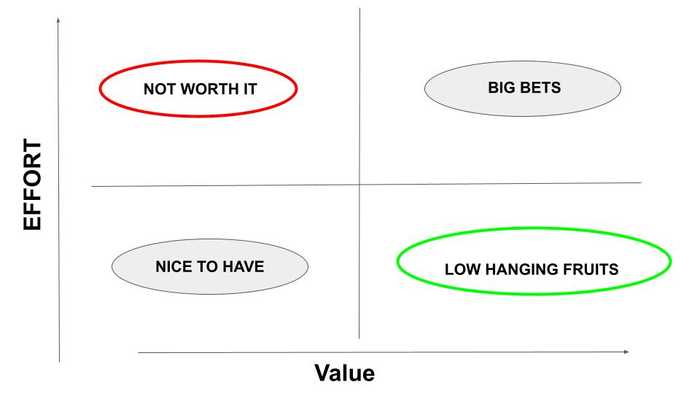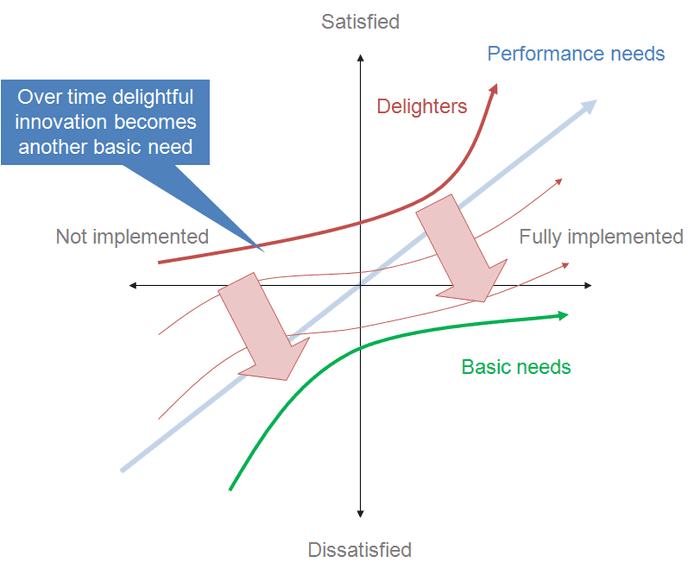11 Prioritization Frameworks You Need to Know
· 11 min read ·

Prioritization is the fun part of product management (lol..I’m kidding). Well it’s fun if you get it right! Setting priorities and aligning the team around it is not easy. Neither is it a one time job. Prioritization is a continuous process. It has three main parts:
There are numerous ways to do it. You can meet stakeholders to understand their point of view, do your own due diligence, look at the market as well. Through these means you collect a ton of information.
Prioritization frameworks help you organize, analyze and communicate information in an easy manner
Lets look at some of them that you might find helpful
RICE
RICE is one of the most popular frameworks. It breaks down prioritization work into four variables and then helps you come up with a score for each project.
REACH
It is the number of people who will see the product update. For example- if you are making a change to your home page then every user visiting the homepage will see it. The unit can be users per day or month or year depending on what makes sense for your business.
IMPACT
The number of people who will use the product update is the impact. For example-if you have a tiered subscription offering- basic, premium and enterprise and you make a change that affects only the enterprise tier then the impact is the total number of enterprise users. Common Units for Impact are:
Very High: 2
High: 1
Medium: 0.5
Low: 0.25
CONFIDENCE
How much do we trust our assumptions? This is tough one. It’s also ironical in some sense because this is also an assumption in itself 😊 . Some way to figure out this value are:
If your answers to both the above questions is YES then your confidence is high because your values are driven by data.
However if this is something that has never been done before then the confidence value will be low. Common units of measurement are:
High: 1
Medium: 0.5
Low: 0.25
You can come up with your own units that work better for you as well.
EFFORT
How much time will it take to launch the product update? This includes time to develop, market, test and finally release and launch. Common units of measurement is T-shirt size:
Very Large(4-8 weeks): 2
Large(2-4 weeks) : 1
Medium(2 weeks): 0.5
Small(Less than 1 week): 0.24
Once you have all these values you calculate the rice score of the update. The formula for this is:
RICE Score=(Reach x Impact x Confidence)/Effort
If you are curious to learn more the RICE framework read our detailed blog on it here
Value vs Effort
This framework uses a 2x2 matrix to help you figure out which areas you should focus on. It look something like this:
It contains two variables:
Each project is plotted on the matrix so that you get a unified view of all the projects. Let’s look at each quadrant:
Big Bets
These are the high value and high effort projects. Often these are big focus areas of the company. A lot of time is spent in validating these ideas through MVP to gauge the demand in the market.
Low Hanging Fruits
Small updates that you should definitely schedule. One of them individually does not have a massive effect. But if you keep plugging at them incrementally they do have a multiplier effect and increase customer satisfaction.
Not Worth It
They do come up very often. In most cases they seem like an easy enough thing to do. Lol..right..as if that’s even a thing 🤣 . But when you look at them closely they turn out to be a huge timesuck with very limited impact. You should ignore these item unless something changes and they move to a different quadrant.
Nice to Have
When some bandwidth opens up in the team especially between the big bets its good to knock off some of these items. They are not super important but will bring value to a few users.
You can calculate the priority score for each piece of work and plot them on the matrix
Formula for Priority Score = Value/Effort
Kano Model
Kano model looks at user needs and puts work in three different buckets.
Basic Needs
Your product cannot exist without these needs being fulfilled. For example if you buy a new laptop you expect the keyboard to function without any issues. If it functions well a customer won’t start jumping with joy. But if it doesn’t work they are going to get real angry real fast 🤬 .
Performancers Needs
Let’s follow the above example. You bought a new laptop. Its battery life is 3 hours. What if it increased to 4 or 5 hours? Your satisfaction with the laptop would increase linearly as the battery life increases.
Delighters
What if I could customize my laptop to match the theme of my favourite anime character. That would make me ecstatic and qualify as a delighter for me.
The key question is how to classify different features into these three buckets. It is based on :
User Story Mapping
The focus of user story mapping is USERS. You chart out the journey of the user from the time they search for your site, land on it and interact with the various elements to complete their activity.
Here is an easy way of developing a story map.
You should not do this exercise in isolation. Do this with a group that represents all customer facing teams.
Check out our detailed blog on User Story Mapping to learn more
Product Tree
This is another fun collaborative exercise to do with the team. Here your “product” is the tree. Other parts of the tree are:
The team gets together and sticks new leaves(sticky notes) to the branches. The closer a leaf is to the trunk the more important it is
It’s a nice visual representation of the product and a great forum for the team to discuss and debate how different ideas compare with each other.
ICE Scoring
ICE stands for Impact, Confidence and Ease. You can think of it as a simpler, lighter version of the RICE framework. The best use of this framework is to pick a winner among a few different competing priorities.
ICE Score = I x C x E
All variables are on a scale of 1 to 10 with 10 being the highest. The item with the highest ICE score goes at the top of the prioritization.
Cost of Delay(COD)
Cost of delay means how much money you will lose by delaying the project. You need two things to calculate COD:
Cost of Delay = 1/2
Higher the COD the more important it is to complete the work.
Buy a Feature
By far the most fun way to prioritize features. If you like board games you will love this. This is how it works in a nutshell:
This is a subjective exercise and has a lot of value when done in groups. You will not take the final outcome and make it your product roadmap. But using the participants’ buy decisions to get to the bottom of the problems they really care about makes the product roadmap user driven.
Affinity Grouping
What you get with this exercise is a a list of prioritised ideas which the team cares about. You can use this as an input into the product roadmap you develop
This is a collaborative exercise that the product team can go through with stakeholders. Here is how it works:
What you get with this exercise is a a list of prioritised ideas which the team cares about. You can use this as an input into the product roadmap you develop.
MoSCoW
MoSCow prioritization is a bit subjective. It does not prescribe a scoring mechanism for the various projects to stack rank. Nonetheless it is very popular because of it’s simplicity. Let’s look at the four parts of MoSCoW
Must Have
You product does not exist without these features. The basic use cases behind the need for the product do not function without these features and functionality. If they break then the usability and capability of the product are adversely impacted. In such cases it’s all hands on deck until these features start working again. For example- You have a B2B application and the industry it’s targeting requires two factor authentication. While 2 factor auth might not be a must have for a lot of products but in this scenario it becomes a Must Have.
Should Have
Let’s follow the same example. Almost all your customers use google SSO for signing into applications they use at work. Now if you have your own signup flow the customers can still use it. But it requires them to do something out of their ordinary flow. So while it doesn’t prevent people from using your product it does create a lot of inconvenience. This becomes a “Should Have” which should be worked on in an upcoming release.
Could Have
These are things that everyone agrees will be useful. But not doing them wouldn’t necessarily create a storm so to say. It’s good to have these lined up for the development team when they have some downtime between larger projects.
Will Not Have
These are things which you do not forsee tackling in the near future. You don’t want to delete them because you never know what the future holds but also don’t want to get distracted by them. So “will not have” becomes the final stop for these projects.
Eisenhower Decision Matrix
The focus of all the frameworks we have talked about till now is product priotization. This one is different. It’s to help fellow product managers. Between fighting fires, talking to customers, writing requirements and a million other things how do you priortize what to work on? The Eisenhower 2 x 2 Matrix helps you manage your day by dividing work into four categories
Urgent & Important
This needs to be done now. It could be a “real” deadline or critical customer facing issue. This makes it to the top of your priority list
Not Urgent But Important
Things that must be done. They can be scheduled in the product roadmap
Urgent But Not Important
This is the work that you create a false sense of urgency for but in reality is not important. These tasks keep you busy and are interruptions - they shift your focus from the important tasks. For example, a text sent by your friend.
Not Urgent Not Important
Example of this is mindlessly browsing the internet for hours. You can do without it.
When you do this exercise for the first time you will be shocked to see how many things land up in the Not Urgent Not Important quadrant.
Conclusion
Like we mentioned right in the beginning of the blog. Prioritization frameworks are a way for you to organize, analyze and communicate what you want to do in an easy manner. All the priotization frameworks discussed have their own pros and cons. You might prefer one over the other based on your needs. So find the one that works for you! If there is a framework we have missed that you’d like us to discuss let us know!








